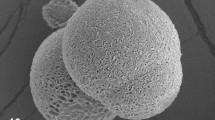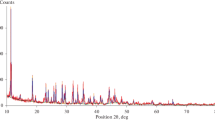Abstract
Despite extensive research, many aspects of the changes that occur in muscovite on heating remain unclear. This study concentrated on quenched samples, to supplement data obtained in situ by previous investigators, which seemed to suggest that structural changes precede dehydroxylation. Samples of muscovite were heated to different temperatures at various heating rates and soaking times, rapidly quenched in air and cooled in a dry atmosphere. Infrared spectra (IR) and X-ray diffraction patterns (XRD) were recorded. Aliquots of a single flake, about 20–40 µm thick, were used for each set of experiments. Thermal changes in these flakes, heated at 10 °C/min, were almost completely reversed at ≤780 °C. Above that temperature, or on more prolonged heating, XRD showed two phases, residual muscovite and dehydroxylated muscovite, with basal spacings ranging between ~19.90–19.94 and ~20.06–20.14 Å, respectively. As dehydroxylation progressed, the basal spacings of all residual muscovites were reduced relative to those of the original samples. The decreases were small, but consistent. The OH stretching bands in IR spectra of the muscovites showed four maxima. After partial dehydroxylation, the frequencies of these maxima remained almost unchanged, but the intensities of the two lower-frequency components were reduced more rapidly than those of the other two. Changes were also observed in the 900- to 600-cm−1 region of the spectra, reflecting changes in the configuration of the tetrahedral sheets. The structure of the dehydroxylated phase changed with temperature. The trends are general, but the details are sample specific. The decrease in basal spacings of residual muscovite and the corresponding changes in the IR spectra, supported by results obtained in situ by previous investigators, indicate that dehydroxylation proceeds through one or more intermediate phases. This differs from dehydroxylation of other phyllosilicates reported in the literature, which do not form an intermediate phase.










Similar content being viewed by others
References
Besson G, Drits VA (1997) Refined relationships between chemical composition of fine-grained micaceous minerals and their infra-red spectra within the OH stretching region. Part II: the main factors affecting OH vibrations and quantitative analysis. Clays Clay Miner 45:170–183
Brigatti MF, Guggenheim S (2002) Mica crystal chemistry and the influence of pressure, temperature, and solid solution on atomistic models. Rev Mineral Geochem 46:1–97
Derkowski A, Drits VA, McCarty DK (2012) Nature of rehydroxylation in dioctahedral 2:1 layer clay minerals. Am Mineral 97:610–629
Drits AV, Derkowski A, McCarty DK (2011) New insight into the structural transformation of partially dehydroxylated pyrophyllite. Am Mineral 96:153–171
Drits AV, Derkowski A, McCarty DK (2012a) Kinetics of partial dehydroxylation in dioctahedral 2:1 layer clay minerals. Am Mineral 97:930–950
Drits AV, McCarty DK, Derkowski A (2012b) Mixed-layered structure formation during trans-vacant Al-rich illite partial dehydroxylation. Am Mineral 2012:1922–1938
Eberhart JP (1963) Etude des transformations du mica muscovite par chauffage entre 700 et 1200 °C. Bulletin de la Société française de Minéralogie et de Crystallographie 86:213–251
Farmer VC (1974) The infra-red spectra of minerals. Mineralogical Society, London
Farmer VC, Russell JD (1964) The infra-red spectra of layer silicates. Spectrochim Acta 20:1149–1173
Fripiat JJ, Rouxhet P, Jacobs H (1963) Proton delocalization in micas. Am Mineral 50:1937–1958
Gaines GL, Vedder W (1964) Dehydroxylation of muscovite. Nature 201:495
Gemmi M, Merlini M, Pavese A, Curetti N (2008) Thermal expansion and dehydroxylation of phengite micas. Phys Chem Miner 35:367–379
Gridi-Bennadji F, Blanchart P (2007) Dehydroxylation kinetic and exfoliation of large muscovite flakes. J Therm Anal Calorim 90:747–753
Gridi-Bennadji F, Beneu B, Laval JP, Blanchart P (2008) Structural transformation of muscovite at high temperature by X-ray and neutron diffraction. Appl Clay Sci 38:259–267
Grim RE, Bray RH, Bradley WF (1937) The mica in argillaceous sediments. Am Mineral 22:813–829
Guggenheim S, Chang Y-H, Koster van Groos AF (1987) Muscovite dehydroxylation: high temperature studies. Am Mineral 72:537–550
Heller L, Farmer VC, Mackenzie RC, Mitchell BD, Taylor HFW (1962) The dehydroxylation and rehydroxylation of triphormic dioctahedral clay minerals. Clay Miner Bull 5:56–72
Heller-Kallai L, Rozenson I (1980) Dehydroxylation of dioctahedral phyllosilicates. Clays Clay Miner 28:353–368
Holt JB, Cutler IB, Wadsworth ME (1958) Rate of thermal dehydration of muscovite. J Am Ceram Soc 41:242–246
Kalinichenko EA, Litovchenko AS, Kalinichenko AM, Bagmut AN, Dekhtyaruk NT (1997) The study of the kinetics and the mechanism of dehydroxylation in muscovite by ESR on Fe3+. Phys Chem Miner 24:520–527
Kodama H, Brydon JE (1968) Dehydroxylation of microcrystalline muscovite. Trans Faraday Soc 64:3112–3119
Langer K, Chatterjee ND, Abraham K (1981) Infrared studies of some synthetic and natural 2M1 dioctahedral micas. Neues Jahrb Mineral Abh 142:91–110
Lapides I (1997) Evaluation of kinetic parameters from single TG curve based on the similarity theory and process symmetry. J Therm Anal 50:269–277
Lapides I, Kovalenko V, Koval P (1977) The micas of rare metal granitoids. Nauka, Novosibirsk (In Russian)
Mackenzie KJD, Brown WM, Cardile CM, Meinhold RH (1987) The thermal reactions of muscovite studied by high-resolution solid-state 29-Si and 27-Al NMR. J Mater Sci 22:2645–2654
Mazzucato E, Artioli G, Gualtieri A (1999) High temperature dehydroxylation of muscovite-2M1: a kinetic study by in situ XRPD. Phys Chem Miner 26:375–381
Méring J (1949) L’interférence des rayons-X daus les systémes a stratification desordonnéc. Acta Crystallogr 2:371–377
Mookherjee M, Redfern SAT, Zhang M (2001) Thermal response of structure and hydroxyl ion of phengite-2M1: an in situ neutron diffraction and FTIR study. Eur J Miner 13:545–555
Nicol AW (1964) Topotactic transformation of muscovite under mild hydrothermal conditions. Clays Clay Miner 12:11–19
Rouxhet PG (1970) Kinetics of dehydroxylation and of OH–OD exchange in macrocrystalline micas. Am Mineral 5:841–853
Saksena BD (1964) Infra-red hydroxyl frequencies of muscovite, phlogopite and biotite micas in relation to their structures. Trans Faraday Soc 57:1715–1725
Sletten VW, Onstott TC (1998) The effect of instability of muscovite during heating on 40Ar/39Ar step-heating spectra. Geochim Cosmochim Acta 62:123–141
Tokiwai K, Nakashima S (2010a) Dehydration kinetics of muscovite by in situ infrared microscopy. Phys Chem Miner 37:91–101
Tokiwai K, Nakashima S (2010b) Integral molar absorptivities of OH in muscovite at 20 to 650 °C by in situ high-temperature IR microspectroscopy. Am Mineral 95:1052–1059
Udagawa S, Urabe K, Hasu H (1974) The crystal structure of muscovite dehydroxylate. J Jpn Assoc Mineral Petrol Econ Geol 69:381–389
Vedder W, Wilkins RWT (1969) Dehydroxylation and rehydroxylation, oxidation and reduction of micas. Am Mineral 54:482–509
Wardle R, Brindley GW (1972) The crystal structures of pyrophyllite-1Tc and its dehydroxylate. Am Mineral 57:732–750
Zhang M, Wang L, Hirai S, Redfern SAT, Salje EKH (2005) Dehydroxylation and CO2 incorporation in annealed mica (sericite): an infrared spectroscopic study. Am Mineral 50:173–180
Zhang M, Salje EKH, Carpenter MA, Wang JY, Groat LA, Lager GA, Wang L, Beran A, Bismayer U (2007) Temperature dependence of IR absorption of hydrous/hydroxyl species in minerals and synthetic minerals. Am Mineral 92:1502–1517
Zhang M, Redfern SAT, Salje EKH, Carpenter MA, Hayward CL (2010a) Thermal behavior of vibrational phonons and hydroxyls of muscovite in dehydroxylation: in situ high-temperature infrared spectroscopic investigations. Am Mineral 95:1444–1457
Zhang M, Redfern SAT, Salje EKH, Carpenter MA, Wang L (2010b) H2O and the dehydroxylation of phyllosilicates: an infrared spectroscopic study. Am Mineral 95:1686–1693
Acknowledgments
We wish to thank the two anonymous reviewers for constructive comments.
Author information
Authors and Affiliations
Corresponding author
Rights and permissions
About this article
Cite this article
Heller-Kallai, L., Lapides, I. Dehydroxylation of muscovite: study of quenched samples. Phys Chem Minerals 42, 835–845 (2015). https://doi.org/10.1007/s00269-015-0767-4
Received:
Accepted:
Published:
Issue Date:
DOI: https://doi.org/10.1007/s00269-015-0767-4




